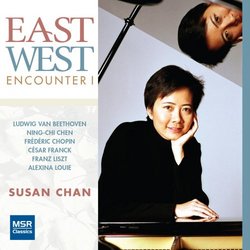| All Artists: Susan Chan Title: East West Encounter I - Works for Solo Piano Members Wishing: 0 Total Copies: 0 Label: MSR Classics Original Release Date: 1/1/2009 Re-Release Date: 10/28/2008 Genres: New Age, Classical Styles: Instrumental, Chamber Music, Forms & Genres, Sonatas, Historical Periods, Classical (c.1770-1830) Number of Discs: 1 SwapaCD Credits: 1 UPC: 681585124529 |
Search - Susan Chan :: East West Encounter I - Works for Solo Piano
 | Susan Chan East West Encounter I - Works for Solo Piano Genres: New Age, Classical
In Cherishing Thoughts of Red Cliff, Ning-Chi Chan s vision of a famous ancient battlefield frames lively heroic scenes and happy times. According to the composer, the piece is inspired by the Sung Dynasty poem of the same... more » |
Larger Image |
CD Details
Synopsis
Product Description
In Cherishing Thoughts of Red Cliff, Ning-Chi Chan s vision of a famous ancient battlefield frames lively heroic scenes and happy times. According to the composer, the piece is inspired by the Sung Dynasty poem of the same title. The work is a pianistic expression of the mood and atmosphere as painted by the poem, namely, the grandeur of Chinese landscape and with it the reminiscence of past heroic events...The contemplative ending conveys...the helplessness of human beings when faced with the giant and unswerving steps of history. Commissioned and premiered by Canadian pianist Jon Kimura Parker, Alexina Louie s Scenes from a Jade Terrace contains three movements: Warrior, Memories in an Ancient Garden, and Southern Sky. In the powerful first movement, the ghost of an ancient Chinese warrior is depicted in fiery and heavy outer sections that contrast with a more contemplative and poetic middle section. The work is striking in its fusion of Eastern and Western musical language and philosophical ideas. Varied temporal organization, Oriental-sounding scales, harmonies and textures result in a rich symphonic poem. Beethovens Sonata in E minor, Op. 90 was written in 1814 towards the late stylistic period of the composer. Terse and concise in its expression, this two-movement work contains much drama and beauty, portraying the love affair of Count Moritz von Lichnowsky, a friend of Beethoven s, with the singer-actress Josefa Stummer. In Beethoven s words, the first movement, in its dramatic dynamic contrasts, is a battle of head against heart. The second, featuring restatement of themes and imitation of voices, is a conversation with the beloved which ends in a lingering departure. Originally an orchestral work, Mephisto Waltz No.1 was transcribed by Liszt himself for piano solo in 1881. It is based on a portion of the Faust legend portrayed by the poet Nicholas Lenau. This section of the poem, entitled The Dance in the Village Inn depicts a wedding feast at which Mephistopheles causes Faust to participate. The text, reprinted in the score, describes the amorous Faust...with a full-blooded village beauty in a wild dance...The sounds of the fiddle grow softer...and the nightingale warbles. Franck composed the Prélude, Fugue et Variation for organ around 1862 when he was organist of the church of Sainte-Clotilde, Paris. This beautiful work contains the essence of French romantic music. It is terse yet full in its expression of delicate and refined feelings; it is spiritual and noble, yet sensuous and passionate. Its form is clean and well-balanced. The Prelude is in ternary form, contrasting the pensive theme in the outer sections with a middle section that embodies much passionate yearning that resembles, as a pupil of Franck expressed it, a flight into the hereafter. In this effective arrangement, the enforcing 16-foot organ stops are translated into thick chords and triplets in the climax of the Fugue. Written in 1844, the Sonata in B minor is the last of Chopin s three piano sonatas. Its refined, powerful expressivity and skillful use of polyphony mark a mature style and a deep reverence for Bach. The first movement juxtaposes a bold and majestic first theme with a lyrical second theme, journeying into counterpoint and colorful harmonies, while the Scherzo contrasts caprice in the outer sections with a lyrical, tender middle section. The slow movement shows the influence of Bellini in its poetic and extended melodic lines supported by a rich array of harmonies. The opening theme of the Finale recurs twice with intensified agitation, and the brilliant coda in B major brings this work to a triumphant conclusion.

 Track Listings (10) - Disc #1
Track Listings (10) - Disc #1